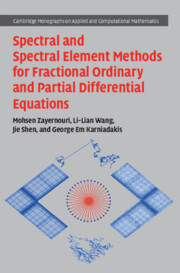Book contents
- Frontmatter
- Dedication
- Contents
- Preface
- Acknowledgments
- 1 Fractional Calculus and Anomalous Transport
- 2 Spectral Expansions and Related Approximations
- 3 Global Schemes for Fractional ODEs (FODEs)
- 4 Global Schemes for Fractional PDEs (FPDEs)
- 5 Integral Fractional Laplacian in Unbounded Domains
- 6 Fractional Laplacian in Bounded Domains
- 7 Time-Integration of Fractional Models
- 8 Applications of Anomalous Transport and Fractional Modeling
- References
- Index
6 - Fractional Laplacian in Bounded Domains
Published online by Cambridge University Press: 31 October 2024
- Frontmatter
- Dedication
- Contents
- Preface
- Acknowledgments
- 1 Fractional Calculus and Anomalous Transport
- 2 Spectral Expansions and Related Approximations
- 3 Global Schemes for Fractional ODEs (FODEs)
- 4 Global Schemes for Fractional PDEs (FPDEs)
- 5 Integral Fractional Laplacian in Unbounded Domains
- 6 Fractional Laplacian in Bounded Domains
- 7 Time-Integration of Fractional Models
- 8 Applications of Anomalous Transport and Fractional Modeling
- References
- Index
Summary
The fractional Laplacian has multiple equivalent characterizations. Moreover, in bounded domains, boundary conditions must be incorporated in these characterizations in mathematically distinct ways, and there is currently no consensus in the literature as to which definition of the fractional Laplacian in bounded domains is most appropriate for a given application. Although the study of the fractional Laplacian is far from complete, this chapter can serve as a proper educational/research starting point for students/researchers in order to employ these operators to model complex anomalous systems. The Riesz (or integral) definition, for example, admits a nonlocal boundary condition, where the value of a function must be prescribed on the entire exterior of the domain in order to compute its fractional Laplacian. By contrast, the spectral definition requires only the standard local boundary condition. We compare several commonly used definitions of the fractional Laplacian theoretically, through their stochastic interpretations as well as their analytical properties. Then, we present quantitative comparisons using a sample of state-of-the-art methods. We finally discuss recent advances on nonzero boundary conditions and present new methods to discretize such boundary value problems.
- Type
- Chapter
- Information
- Spectral and Spectral Element Methods for Fractional Ordinary and Partial Differential Equations , pp. 485 - 579Publisher: Cambridge University PressPrint publication year: 2024

